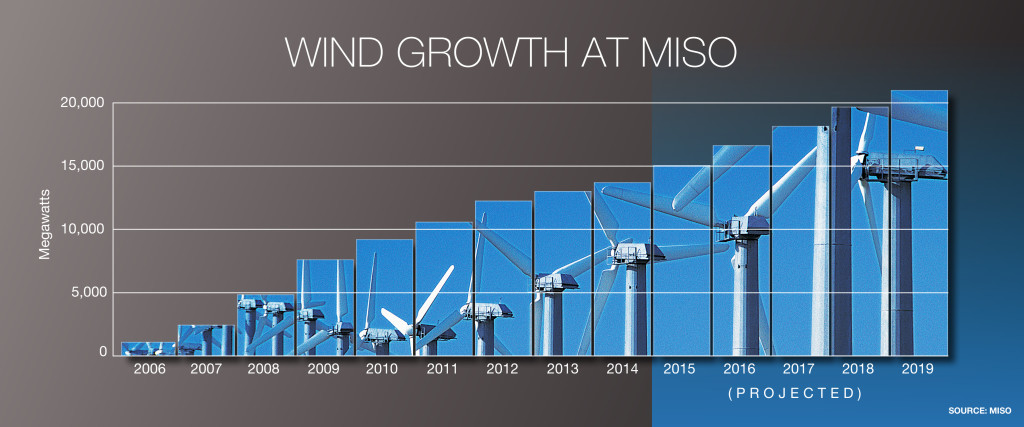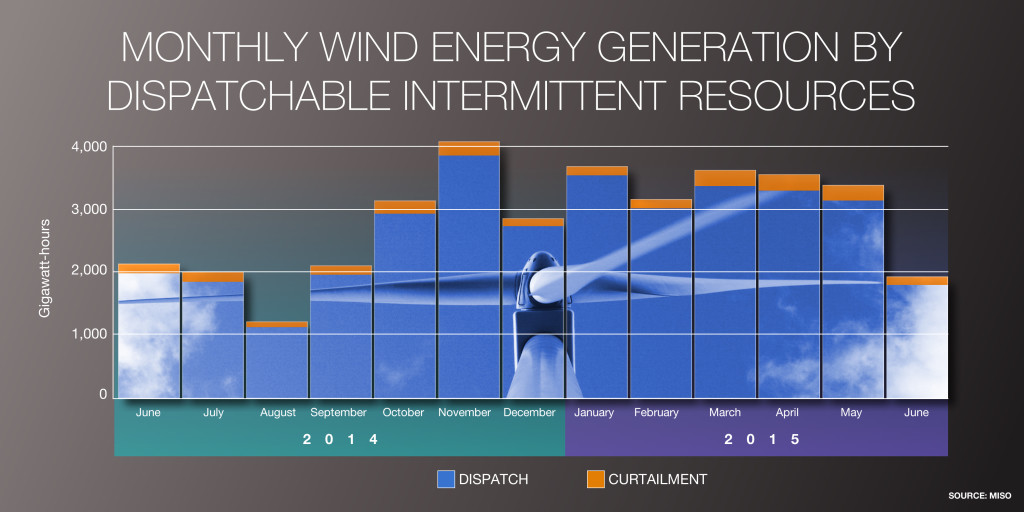The Story in Brief
Kristian Ruud is Senior Manager, Engineering Support at MISO, the grid operator that serves the Midwest United States and the Canadian province of Manitoba. In this interview with EPRI Journal, Ruud discusses MISO’s experiences with an innovative new program to manage and integrate rapidly growing intermittent wind resources.
EJ: Describe the operational challenges that led MISO to rethink how it manages intermittent wind resources.
Ruud: Between 2005 and 2010, we had an explosion in wind deployment that was outpacing transmission development. We ended up with a lot of generation in areas that didn’t traditionally have much generation or load, and the transmission system in those areas wasn’t robust enough to support that generation. This led to a great deal of local transmission congestion, and we didn’t have traditional generation resources that could be effectively re-dispatched to alleviate those constraints.
A good example was in southwestern Minnesota, one of the first regions in the MISO’s service territory to see significant wind development. This rural area was traditionally served by remote generation facilities. As the wind capacity in the area increased and exceeded the local load, it led to eastward energy transfers on the transmission system along the Minnesota/Iowa border. The existing transmission infrastructure, mostly consisting of a single 161-kilovolt line, was quickly overwhelmed by these transfers, and there was not enough traditional generation to “push back” on the transfers.
In this and other instances of congestion, our only option was to pick up the phone and call the wind operators to tell them to curtail production. This “manual” curtailment process, without a robust operator tool supporting it, has a number of drawbacks. It doesn’t send the appropriate price signals to the market to indicate that transmission congestion is present and to help reduce it. Our operators were spending nearly all day every day tracking transmission congestion, figuring out who needs to be curtailed and by how much, making the phone calls to implement the curtailments, tracking the results, and ultimately reversing the process to release the curtailments. All this took their attention away from other important activities.
These were the main drivers to create our Dispatchable Intermittent Resources program in 2011. This program effectively eliminates manual wind curtailment. Our intent was to find the most cost-effective dispatch of all dispatchable generating resources on the grid while respecting transmission limitations. The program aims to treat wind resources like any other generating resource in MISO’s real-time market.
One major obstacle was that other resources in our market have to give us data on their minimum and maximum production on an hourly basis at least 30 minutes before the start of any given hour. It isn’t practical to use that construct for wind because it varies significantly over that 90-minute period. So we created a mechanism by which wind power operators provide generation forecasts for each 5-minute interval, and these forecasts are treated as the maximum production for each interval. They can update these forecasts as often as they want, but they have to give us a forecast at least 10 to 15 minutes prior to the interval in question.

Besides that 5-minute forecast, the Dispatchable Intermittent Resources provide the same parameters with their electricity offers as any other generation resources, such as ramp rates and price curves. The price curves given by wind generators indicate the prices below which they would be willing to curtail production. These numbers can be close to zero or even negative.
Our computer systems collect and automatically process all this information to determine market dispatches in megawatts for every 5-minute interval. MISO then sends dispatch signals to wind resources through a communications protocol just like it does for any other resource. Curtailments are built into this automated process by issuing dispatches below the current generation capability of a wind operator.
EJ: How are the wind production forecasts done, and what are their limitations?
Ruud: Before the Dispatchable Intermittent Resources program, we used hourly wind generation forecasts that went out over the next seven days. Now, for Dispatchable Intermittent Resources, we collect wind generation forecasts for each 5-minute interval over the next hour. Some wind power operators submit their own forecasts to us. Others decided to use MISO’s 5-minute forecast. These forecasts feed into our automated dispatch.
Sub-hourly wind forecasts are based on persistence logic—in other words, forecast output in the next 10 to 15 minutes is whatever the current output is. Keep in mind that 10 to 15 minutes is not much more than the 5-minute intervals for our dispatches. With this forecasting approach, we’re not very good at predicting output during up or down ramping, and that erodes the effectiveness of the Dispatchable Intermittent Resources program. For now, we’re able to manage around forecasting challenges either by manually intervening or accepting short-term inefficiencies. We’re engaged with industry groups focused on forecasting and are also vocal about our concerns with the sub-hourly forecast capability. Besides this challenge, the program has been successful overall.
Wind power forecasting is a relatively new science. Most of the wind forecasting prior to the wind generation boom was for aviation and weather, which forecasts five, ten, fifteen thousand feet in the air, not a few hundred feet.

EJ: What has been the typical forecast error with your program?
Ruud: We have error metrics, but they don’t tell the full story. Wind output is fairly steady for long periods, and the ramping periods—where the largest error occurs—are relatively short-lived. This nuance is not easily captured in a metric. Consider this example: we have a 100-megawatt wind farm that went from zero megawatts to full output and then back to zero in 3 hours. During this time, the forecast was off by 3 to 40 megawatts. The rest of the time, the forecast error was considerably lower.
We’re aided by our large geographic area and large number of wind farms. If one farm is ramping up in southwestern Minnesota, another one in northeast Iowa may be moving down. The geographic diversity tends to cancel out some small ramping periods. Because about 90 percent of our wind resources are in Minnesota, Iowa, and the Dakotas, we do get large output increases when a weather front moves through that region, but that ramp happens over hours, not 10 or 15 minutes.

EJ: What are the program’s key successes?
Ruud: One main success is transparency in the market. When we manually curtailed wind operators in the past, they would wonder, ‘Why am I being curtailed? What is the constraint? How can I help fix the problem?’ Standards of conduct limit what we can tell them in that context. Also, with the old system, prices did not reflect transmission congestion and the need to curtail, because we were simply masking the problem through manual action. Now curtailments are part of our automated market dispatch, and we’re posting information on transmission constraints in real time on our website, so everyone can track their impact on the grid. With our dispatches, we use algorithms to calculate prices that more accurately reflect transmission and generation constraints. Additionally, wind generators in our market can now submit offers and set prices that factor in system conditions.
The program makes the market more efficient. Previously, when our operators issued curtailment orders, they were not reviewing and adjusting the curtailment every 5 minutes as needed. When it came to easing curtailments, they had to err on the conservative side to make sure that they didn’t damage the transmission system. Today, because our market operates every 5 minutes, it can continually optimize the curtailment in the dispatches. That means we’re able to let more megawatts on the system.
EJ: How are operating reserve requirements impacted by wind variability and uncertainty?
Ruud: Because of MISO’s large size, both geographically and in terms of load, we haven’t seen a need to increase our reserves due to growing wind resources. As I mentioned previously, while wind may be increasing over here, it’s decreasing over there, and that smooths out the overall system production. Ramping up or down takes place over hours rather than minutes. With our 5-minute dispatch, this ramping pattern has little impact on reserve needs at the current wind penetration.
EJ: Many states in MISO’s service territory have ambitious renewable energy mandates that will drive substantial wind capacity increases over the next 10 to 15 years. What additional operational challenges do you expect from this?
Ruud: Several years ago, we did a study concluding that we don’t need any additional operating reserves for wind capacity up to about 20,000 megawatts. We’re currently at about 14,000 megawatts. So while this is not a pressing concern now, we have taken some steps to prepare for continued growth.
We’re developing a ramp capability model to help during times when a significant generation ramp is needed, such as during the morning load increase. This model helps to quantify the resources needed to provide that ramp and ensure that there are enough resources that can move fast enough during a specific time. This is different from having enough resources to meet the peak load. For example, if wind is dying off during the morning load increase, we need to be able to move fast enough to keep up with that load even if it’s not going to be a peak load day.
We’re also implementing a new pricing approach, called extended locational marginal pricing, which enables fast-start energy resources that are offline or scheduled at their operating limits to set prices. It also enables emergency demand resources to set prices. These are the resources that can help smooth generation profiles in a market with more intermittent generation.
EJ: What can other grid operators learn from MISO’s experience?
Ruud: As grid operators, we have a responsibility to manage the grid efficiently and reliably, and that may require changing our business practices as the system changes. We must remain flexible.
The biggest thing we’ve learned from engaging with the industry is that no two grid operators are the same. Our major operational challenge with wind penetration was transmission congestion. Many smaller operators have a much bigger challenge with balancing wind generation and load. We’re each going to have unique issues, but that doesn’t mean that we can’t learn from each other. We’re not going to have the solar penetration that California is expecting, but we’re still monitoring that market and how the grid operator is responding to challenges. Talking with our neighbors and sharing operator experiences will help us deal with the challenges ahead.
EJ: What R&D is needed to help grid operators integrate wind and other renewable and emerging technologies?
Ruud: The biggest need is enhancing the sub-hourly wind and solar forecasts. The less uncertainty grid operators have to deal with, the better they can operate the system. Solar poses a different set of forecasting and operational challenges, particularly because operators need to manage small distributed rooftop solar along with much larger utility-scale solar installations. Today’s grid monitoring tends to make solar generation look like a reduction in load. Operators need better tools to differentiate between load reduction and generation.
Artwork by Craig Diskowski/Edge Design
One thought on “Grid Operator: Riding Midwest Winds”
Comments are closed.



As a PMA engineer, my bias has always been with hydro and steamer units providing the base load, and having the units ramp up and down to manage “green” variability. I was skeptical of wind, and thought wind was too risky to allow wide spread adoption on wide area grids. Your article was very informative and well written. My bias is now adjusted. Perhaps that is one of the many roles of EPRI … teach an old dog new tricks. Thanks.